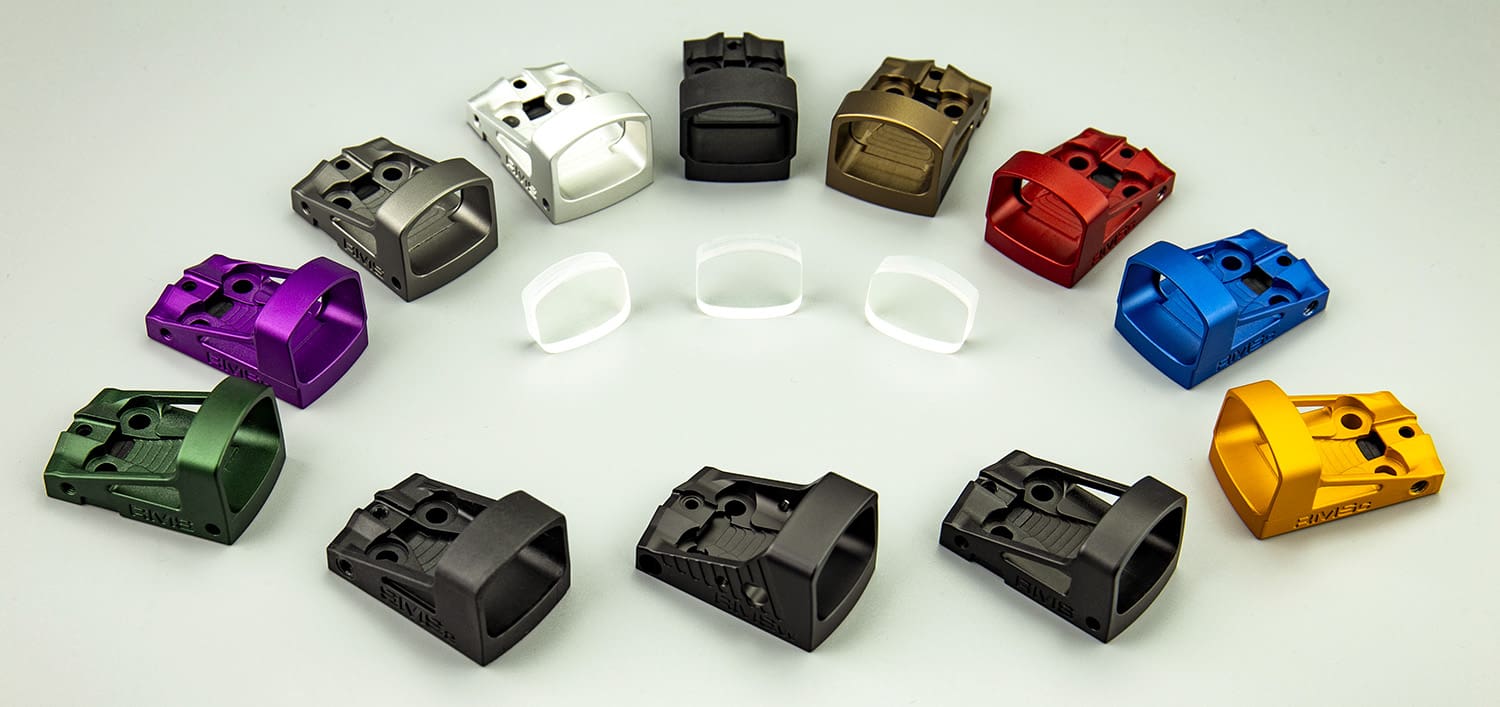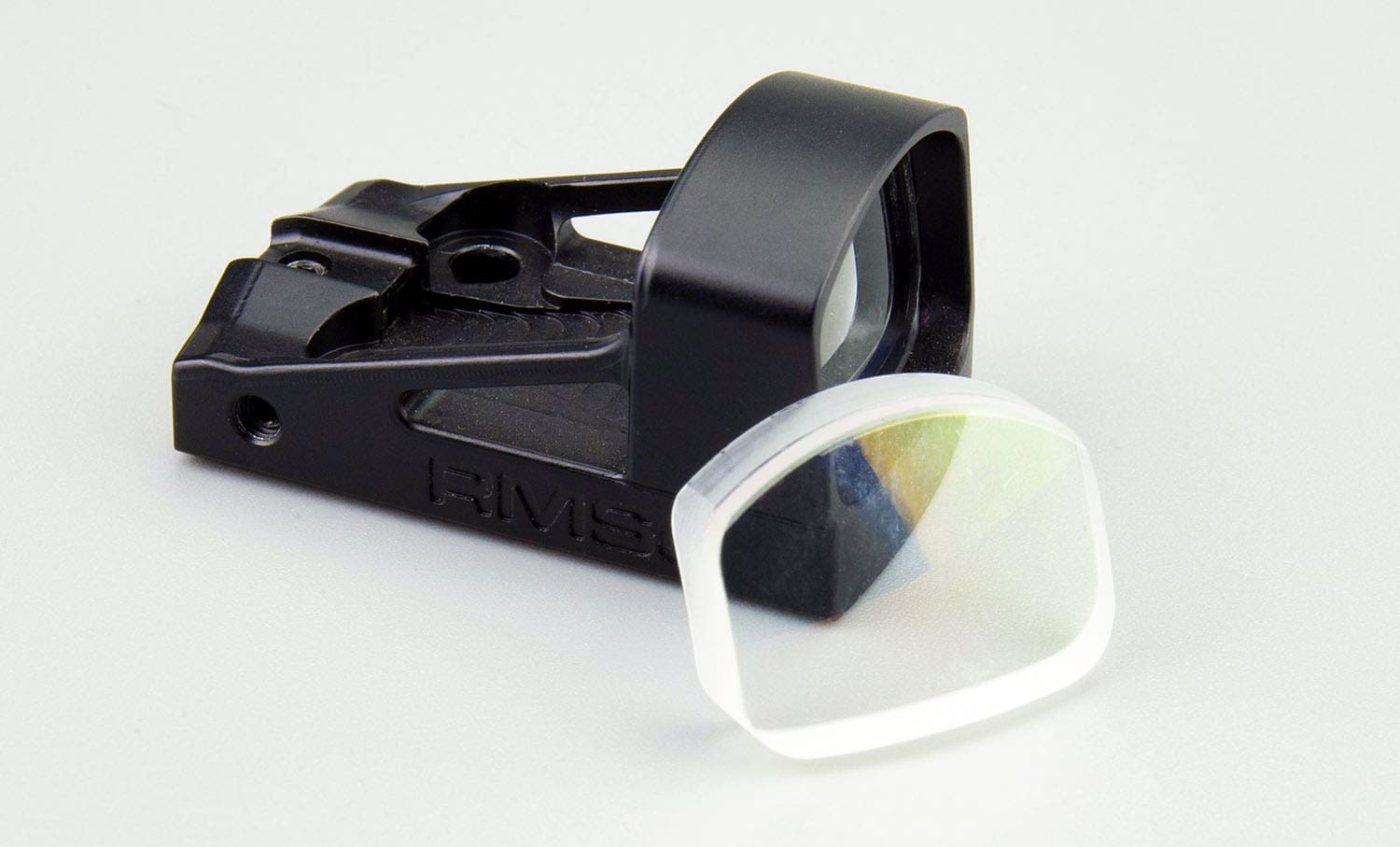Dorset, England, U.K: Shield Sights, leader in mini red dot innovation, has added an all glass lens as a custom option for the RMS, RMSw, RMSc, and SMS sights.
The addition of an all glass lens provides a solution to customers looking for maximum scratch resistance. The glass lens is clear and uncoated for maximum clarity in all shooting situations. The glass lens has no magnification value and provides a true representation of the shooting environment.

Customers looking to order an optic with a glass lens, will select it as an option within the Customizer widget under products on the website. Customers ordering a custom optic from the website, will be able to select model, color, dot size, and lens material. Customers ordering custom optics can expect their product to ship within 4-6 weeks after the time of ordering.
Custom Options & Features
- Colors include Blue, Bordeaux Red, British Racing Green, Bronze, Crimson Orange, Silver, Gunmetal Grey, and Purple.
- Type III Sulfuric Acid Anodizing
- Dot sizes include 4MOA and 8MOA
- Lens options SiO2 coated polymer, or all Glass lens
- Delivery within 6 weeks
Full Custom Optics
MSRP: 425 – 500 Euro
MSRP: 500 – 600 USD
To order visit: https://www.shieldpsd.com/customizer
About Shield
SHIELD was formed in the early 1980’s in Great Britain. Shield continues to manufacture the world’s smallest, lightest, toughest mini red dot sight. Sold under other brand names for many years, you may know the Shield Mini Sight as the Firepoint, Tasco Optima, Trijicon Red Dot or JPoint. Based on our in-depth knowledge, accumulated through 30-years in the industry, we are continually seeking to develop innovative products that will enable you to hit the target early.





I think these are interesting, but I’m not convinced the tiny window is better than a good set of irons. Someone let me know. Plus, if it’s a small enough gun to need this size red dot, then you got a small gun for easy concealment. Mounting a red dot hurts the easy concealment / comfort factor.
RDS on pistols make for fast target acquisition. Even small windows work. In really close cqb just seeing the target through that window usually works.
Cool.
Using red dots on pistols is impossibly slow when in unusual positions. The dot is often off screen. You then have to align the gun with the fixed sights, then go back to the dot.
They only work when you have perfect presentation which does not happen in real life defensive shootings.
My minimal experience with an optic on a carry gun is that there’s no time to turn it on. It’s going to be a quick unholster and use point shooting or the irons; I don’t practice low-and-ready for a DGU senario. An optic is great for a range gun, LE, or Mil use. IMO, not so much for concealed carry. YMMV
If your dot isn’t in the window, then your sights aren’t aligned and you need to take the extra time to move them too.
People get wrapped up in dots being difficult to use. If you can’t see the dot, your sights aren’t aligned either. If your dot is in the window, that’s where the round is going. Not so much if your sights are off an equal amount.
People like to say that up close and quick you either can’t find the dot, or won’t be using sights anyway. If that’s the case irons won’t be much help either. People try dots in a shop or a few mags at the range and say its not for them. Lo and behold, you need to practice. Practice, and it doesn’t matter your position or angle. Bring the gun closer to your face and the dot is nice and easy to pick up when you’re contorted behind the gun. Shooting from compression with the gun at face level instead of at the chest.
Replying to SoCalJack, many of these micro red dots are always on anyway. I know for a fact that jpoint/shield models are
The dot is good for initial acquisition (muscle memory, practice your draw) and for keeping the field of view open – which is incredibly helpful for distance and engaging targets at varying distances.
If Red Dots are a fad or not that useful, why are they now dominating pistol competition and why are they pretty much standard equipment for our military rifles and special forces pistols?
As for “you don’t have time to turn it on” argument – that’s a non-argument. You leave it on, always. Change the battery annually (most have 2-3 year battery life if left on constantly). Holosun even makes one that’s solar powered.
Finally – most good setups will still allow co-witness with irons in the event the device fails.
No….thank…you.
Flame away but I can get a glass windshield for they price though it may look silly on my pistol.
Mrs. Lead,
Make sure the windshield is tinted; you don’t want glare affecting your target aquisition.
This is the first picture of an RMR with the glass removed, that I’ve seen. I presume that if the glass is that thick, it must be a Magnin mirror design. That’s the design that Aimpoint patented, long enough ago that the patent must be inoperative by now.
They never tell you in the ads. They always say it’s parallax free, which is never exactly true. The Magnin mirror has much less parallax, if it’s a Magnin mirror.
From Britain? I thought they didn’t have any guns in Britain. I guess they just like to look through red-dot sights.
silly redcoats, still can’t make up their mind if they want to be free or not.
I have a Shield RMS with the 4 MOA dot and really like it. I had my Glock slide milled to install it as low as possible, and the built-in irons on the back of the RMS work perfectly with the stock front sight. Literally my only complaint is that it was way too easy to scratch the lens while cleaning it. I scratched mine probably with piece of sand or dirt. The option of a glass lens that’s harder to scratch is a much-needed upgrade.
To answer Dude’s question, I’ve got a .22 Buckmark with a red dot on it. I like it a lot as a target pistol. I’ve tried to do some timed and rapid fire starting from a low ready position, and sometimes I get it lined up quickly and sometimes not.
If you need a red dot for up close and personal defensive shooting you probably should use that money lazic eye surgery or a great big seeing eye dog. Forget any firearm other than a gatling gun and use the tried-and-true spray and pray method of defense.
@Sam Hill:
Does the dog need a concealed carry license???
I never thought I would say this, but I miss the ‘pocket dump of the day’, because I would have dropped this question there. But it’s gone, soooo…
I need to hear from TTAG’ers who have had cataract surgery. I shoot right-eye dominate, sometimes with a scope. Since I’m not wealthy and am paying the entire cost of the surgery and the lenses out-of-pocket, is there a recommended way of having this done? I doubt I will be able to afford the high-end lenses that can auto-focus near and far, so at this point, it looks like the mixed-lens install may be the way to go, one eye set up with a distance lens, the other, for close-up work.
The question is, when using a scope, is the image you see in the scope your eye focused distant, or close up?
Geoff:
My advice is that you consult your ophthalmologist for a discussion of the pros and cons. I have cataracts too and may have to face this in the future (but not yet). However, to me, having two eyes focused differently sounds like a very bad idea.
That seems to be a very common way of doing it, and what I have been reading suggests in about 2 weeks time, your brain ‘adapts’ on its own and ‘fills in the missing data’ and you don’t notice it any more.
It could be bullshit, my experience level with this is zero-point-zero, hence, why I’m asking others experiences…
I have really poor vision, and I’ve had to drive with only one contact before. It was not fun.
You might want to consider going to one of those places that advertise $100 glasses and have a pair made like this and try it out for a few weeks. At least then you are only out $100 instead of stuck with something you don’t like.
That’s not a bad idea at all…
Get them both for distance and just use reading glasses.
I’m kinda leaning in that direction, thanks…
Comments are closed.